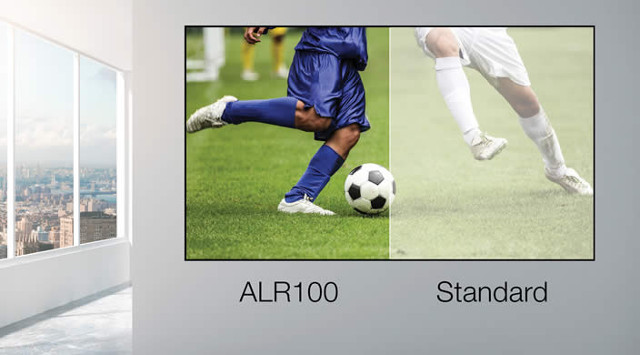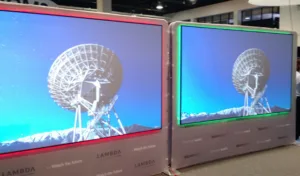MicroLite was at InfoComm to show off its existing screen materials, but we also learned of two new screens that will debut in August.
The company only offers front projection screens in sizes up to 150 inches in a 16:9 ratio. Current products include 1.2 and 2.4 gain materials. The advantage the company claims for their screen materials is the ability to have high gain and wide viewing angles simultaneously.
In August, the company plans to introduce a new short throw material with a gain of 2, which they believe will be the first short-throw material with a gain in excess of 1.2. They currently offer a 1.2 gain short throw screen but most others offer a 1.0 gain product. They see this screen being used for HDR content where more gain will be needed. They said most screens use a bark dye to help with the blacks and contrast, but this can be a problem when screening HDR content.
The company is also working on its first optical screen that they say will reject up to 80% of the ambient light while also having a wide viewing angle. This will be offered in screen sizes up to 100 inches when it debuts in August.
elunevision has developed a novel approach to projection screens that steals the idea behind the Philips ambilight LCD TVs. The idea is to add LED light strips around the edges of the projection screen to create some ambient mood lighting for a projector solution. They call it a Lambda screen.
The company makes their own screen material. One option for Lambda screen is an acoustically woven 4K capable white material, called Aurora, that can be offered from 92” to 150”.
They also offer an ambient light rejection material that is a multi-layer coating on a rigid substrate. It has a gain of 1.3 and a viewing angle that is “better than the Black Diamond screen from Screen Innovations.”
The Lambda screen with the matte white material can be rolled up along with the frame and LED strips to be able to deliver in a small package. The illumination is not coordinated with the content in the way that Ambilight is, so there is a controller to allow the user to vary the colors. A 120” 16:9 version sells for $2,500 MSRP. elunevision is currently looking for US distributors.
Draper had no new screen materials or other products to announce at InfoComm. They were focused on talking about their TecVision screen materials introduced about a year and half ago. This is a screen material that is custom fabricated for each client to fit exact requirements for the room and application. TecVision features white surfaces with gains ranging from 1.3 to 1.9 over wide viewing cones, and grey surfaces with excellent performance under higher room light levels. These premium surfaces are not sold online and are only available through qualified Draper dealers. They are also ISF Certified for color accuracy and are compatible with 4K resolution images (something the prismatic structures are not).
DNP only had one bit of hard news – the extension of the screen size of its Supernova STW short throw screens for wide viewing angles, to 120 inches. DNP thinks they have the broadest range of ambient light rejection (ALR) screens in the industry, which they described recently in a presentation at Display Summit China. (DNP Focuses on Short Throw Screens)
For example, the Supernova STS is based on a Fresnel lens structure that absorbs light from one vertical direction and accepts light from the other direction. It offers a standard viewing cone in screen sizes up to 100 inches in 16:9.
Supernova STW uses a black/white lenticular design that expands the half angle to 85 degrees. This is screen that can now be made in sizes up to 120 inches.
The Supernova STE is like the STW but designed for tiling and edge blending application. This was demonstrated at InfoComm and can create screens up to 181” in a 32:10 aspect ratio or 231” in a 46:10 aspect.
About a year ago, DNP launched the DNP LaserPanel. This is a Supernova screen – short throw projector bundle. At InfoComm this year, they showed the projector integrated into some nice Danish furniture to showcase how elegant this solution can look in a corporate office. While this 100” solution is about the same cost ($6500) as an 80” flat panel, it is not selling as well as expected. This is not because of the product, DNP thinks, but rather some channel challenges they need to work through. New distribution through the IT channel and VARs will be tried soon.
A version with a touch interactive capability and wireless dongle is also available in the US for $8500. This uses a different projector and is mounted above the screen.


Volfoni and Severtson joined forces to present 3D projection solution that includes Volfoni’s SmartCrystal Pro Booster, that was launched this February. This is an optical component that sits in front of the projection lens to create an active polarization switching solution allowing passive polarized glasses to be used to see the 3D content. This leverages similar products offered to cinema operators and includes heat sensors and automation capabilities accessible via smartphone.
From Stevertson’s side there were be various screens and framing solutions displayed.
Apparently, Optoma, at least Optoma UK, also sells screens along with their projectors. Optoma UK has just launched a new ambient light rejecting screen called the ALR100. It is a specialized screen surface that is designed to actively reflect a projected image for high contrast and solid color saturation while preventing ambient light from washing out the picture. A 100-inch fixed frame screen will be the first product offered and is designed to be coupled with short throw projectors like the Optoma GT5500 and GT5000 projectors at a distance of 30 cm.

The ALR100 features a 0.42 gain material with wide viewing angles and a narrow bezel (11mm) design. Optoma says it “also enables deeper black levels for fine details in darker scenes – even with the lights on.” No details on price or availability were released, however. – CC

